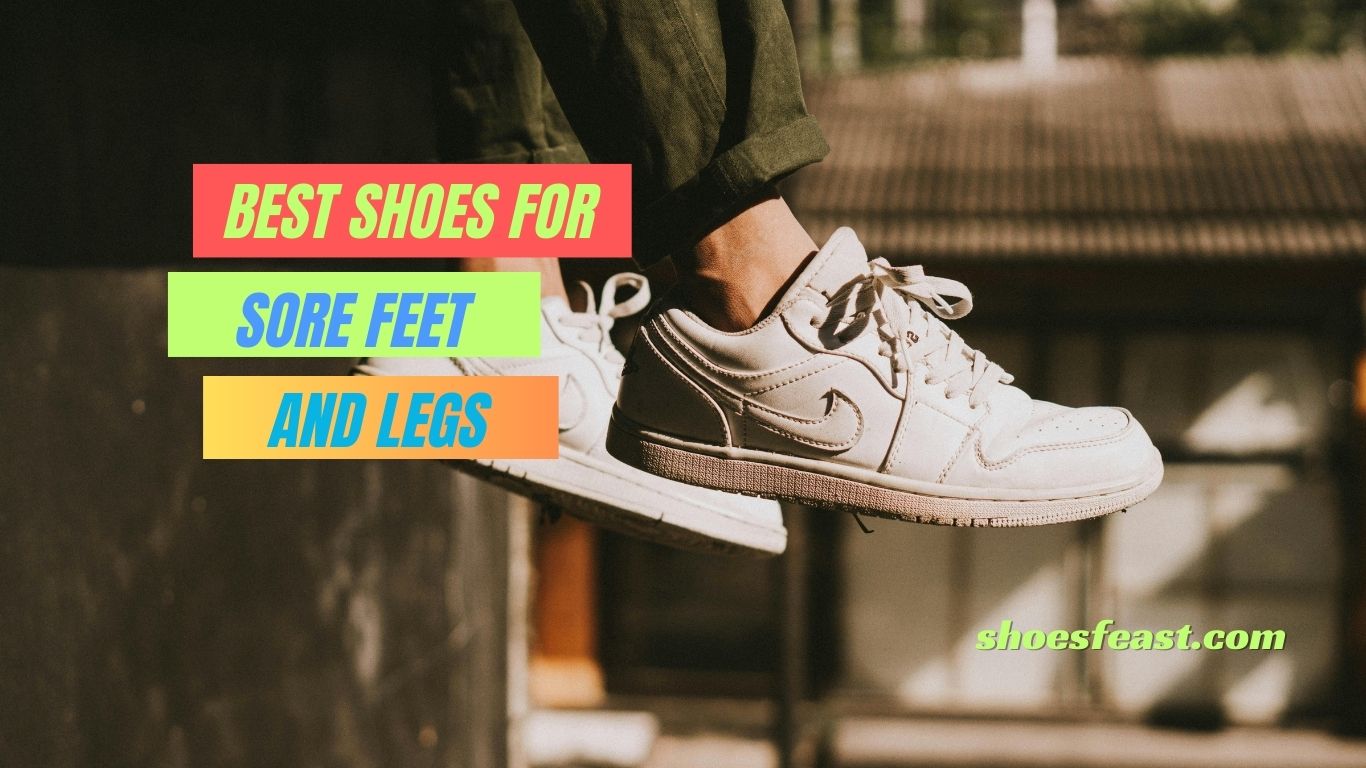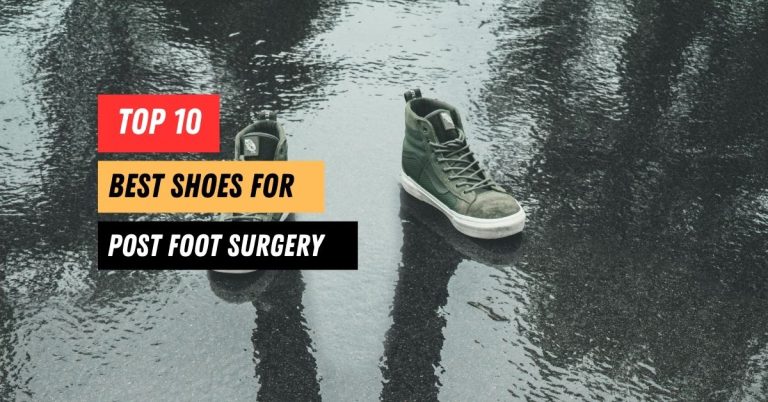10 Best Shoes for Sore Feet and Legs
Choosing the right shoes is pivotal for those experiencing sore feet and legs, as proper footwear can significantly impact comfort and mobility. The right shoes not only alleviate pain but also support and stabilize the foot and leg muscles during daily activities or strenuous tasks.
It’s essential for individuals suffering from foot and leg discomfort to select shoes that will aid in performance and prevent further injury. This article aims to guide you through the selection process, helping you identify the most suitable options that blend comfort, durability, and appropriate support, ensuring your feet feel as good at the end of the day as they did at the beginning.
Top 10 Shoe Reviews for Sore Feet and Legs
1. ASICS Gel Nimbus 22
The ASICS Gel Nimbus 22 stands out for its exceptional cushioning and support, making it a top choice for individuals with sore feet and legs. The shoe features ASICS’ Gel technology, which provides superior shock absorption and enhances comfort during prolonged wear. The lightweight FlyteFoam Propel technology in the midsole offers an energetic ride, while the shoe’s breathable mesh upper ensures your feet stay cool and dry.
Its spacious toe box and plush collar prevent any irritation or pressure points. Additionally, the Impact Guidance System (I.G.S.) enhances the foot’s natural gait, reducing strain on the legs and feet.
Pros:
- Exceptional cushioning with Gel technology
- FlyteFoam Propel technology for a responsive feel
- Breathable mesh upper keeps feet cool
- Spacious toe box and plush collar for comfort
- Enhances natural gait with I.G.S technology
Cons:
- Higher price point
- May be too cushioned for those preferring a firmer feel
2. Brooks Ghost 13
Brooks Ghost 13 is renowned for its balance of soft cushioning and stable support, ideal for sore feet. It features the BioMoGo DNA and DNA LOFT cushioning, which work together to provide a just-right softness without losing responsiveness and durability. The shoe’s engineered mesh upper offers both stretch and structure, adapting to the shape of your foot.
The Segmented Crash Pad—an integrated system of shock absorbers—ensures smooth transitions from heel to toe. The Ghost 13 also has a high energizing cushion, which makes it perfect for all-day wear, and its slight underfoot curve aids in relieving leg fatigue.
Pros:
- BioMoGo DNA and DNA LOFT cushioning for softness and durability
- Engineered mesh provides stretch and structure
- Segmented Crash Pad for smooth transitions
- High energizing cushion ideal for all-day comfort
- Supports natural foot motion
Cons:
- Some users may find the fit too snug
- Not as lightweight as some competitors
3. New Balance 990v5
The New Balance 990v5 combines a classic look with cutting-edge comfort technology, making it a staple for those with foot and leg pain. It features ENCAP midsole technology which provides support and maximum durability. The upper is crafted from premium pigskin leather with mesh inserts, offering both durability and breathability.
The dual-density collar foam protects your ankles, and the blown rubber outsole provides excellent traction. This model is praised for its versatility and orthotic-friendly design, making it suitable for a wide range of foot types and needs.
Pros:
- ENCAP midsole technology for support and durability
- Premium pigskin leather with breathable mesh
- Dual-density collar foam for ankle protection
- Orthotic-friendly design
- Versatile and stylish for various settings
Cons:
- Heavier than some other models
- Premium price tag
4. Hoka One One Bondi 7
Hoka One One Bondi 7 is highly regarded for its maximalist cushioning that provides ultimate comfort for sore feet. The shoe features a full EVA midsole, breathable mesh upper, and a memory foam collar, ensuring comfort from every angle. Its Meta-Rocker technology helps in maintaining a natural walking gait and reducing pressure on the forefoot.
The wide platform enhances stability, making it a great choice for those needing extra support. The Bondi 7’s cushioning is responsive and durable, designed to withstand long hours of wear without compromising comfort.
Pros:
- Maximum cushioning with full EVA midsole
- Memory foam collar enhances comfort
- Meta-Rocker technology supports natural gait
- Breathable mesh upper
- Wide platform for enhanced stability
Cons:
- Bulky appearance may not appeal to all
- Less responsive than more streamlined models
5. Skechers Arch Fit
Skechers Arch Fit is a game-changer for those with sore feet, thanks to its podiatrist-certified arch support. The shoe provides a balance of stability and flexibility with its Arch Fit insole system, which distributes pressure across the foot. The breathable mesh upper ensures comfort during prolonged use, while the flexible rubber outsole offers good traction.
These shoes are particularly beneficial for those with arch-related issues or flat feet. The overall design is lightweight and stylish, making it suitable for both casual and more active settings.
Pros:
- Podiatrist-certified arch support
- Balances stability with flexibility
- Breathable mesh upper for long-wearing comfort
- Lightweight and stylish design
- Suitable for a variety of settings
Cons:
- May require a break-in period for optimal comfort
- Some users report sizing inconsistencies
6. Merrell Moab 2 Ventilator
The Merrell Moab 2 Ventilator is an excellent choice for individuals with sore feet who need sturdy and breathable footwear. This hiking shoe features a supportive footbed with zonal arch and heel support, made from Merrell’s M Select FIT.ECO+ blended EVA. The shoe’s suede leather and mesh upper provide durability and ventilation, reducing moisture and enhancing comfort during long wear.
The Vibram TC5+ sole offers excellent traction on various terrains, while the air cushion in the heel absorbs shock and adds stability.
Pros:
- Excellent arch and heel support
- Durable suede leather and mesh upper
- Vibram TC5+ sole for superior traction
- Air cushion in the heel for shock absorption
- Breathable design suitable for hot conditions
Cons:
- May feel stiff initially
- Heavier than typical urban walking shoes
7. Adidas UltraBoost 21
Adidas UltraBoost 21 is praised for its responsive cushioning and energy return, thanks to its Boost midsole, making it an ideal running shoe for those with leg and foot soreness. The shoe features a Primeknit upper that comfortably wraps the foot while providing breathability.
The Linear Energy Push system increases forefoot and midfoot stiffness for added responsiveness. This model also incorporates recycled materials, making it a more sustainable choice. The Stretchweb outsole with Continental Rubber offers excellent grip in wet and dry conditions.
Pros:
- Responsive Boost midsole
- Primeknit upper for adaptive support
- Linear Energy Push system for enhanced stiffness
- Sustainable materials in construction
- Excellent grip with Stretchweb and Continental Rubber outsole
Cons:
- High price point
- Some find the design bulkier than previous models
8. Nike Air Zoom Pegasus 38
Nike Air Zoom Pegasus 38 is a versatile running shoe that provides robust support and cushioning, ideal for alleviating discomfort in the feet and legs. The shoe includes a full-length Zoom Air unit for a smooth, responsive ride and Nike React foam for durable cushioning.
The mesh upper adapts to the foot for a breathable and comfortable fit, while the wider forefoot provides more space for toe movement. This model is well-suited for both casual runners and those who spend long hours on their feet.
Pros:
- Full-length Zoom Air unit for responsiveness
- Durable Nike React foam cushioning
- Mesh upper for a comfortable, adaptive fit
- Wider forefoot offers more toe space
- Suitable for running and daily wear
Cons:
- May require a break-in period
- Some users report less arch support than needed
9. Clarks Unstructured Un.Loop
Clarks Unstructured Un.Loop is an excellent casual shoe for people with sore feet, thanks to its unique unstructured design that offers a comfortable, no-bind fit. The shoe features a full-grain leather upper that provides a breathable and flexible environment for your foot.
The lambskin lining ensures no irritation and reduces moisture. The Air Circulation System and internal air channels promote air flow, making them cool and comfortable. Additionally, the OrthoLite footbed adds cushioning and shock absorption.
Pros:
- Full-grain leather upper for breathability and flexibility
- Lambskin lining for comfort and moisture reduction
- Air Circulation System keeps feet cool
- OrthoLite footbed for cushioning and support
- Easy slip-on design
Cons:
- Not suitable for very active settings
- Higher price tag for casual footwear
10. Saucony Triumph 18
Saucony Triumph 18 is designed for runners but is equally beneficial for anyone seeking relief from foot and leg pain. It features a new midsole formulation that increases responsiveness and durability, while the FORMFIT system surrounds the foot in a made-for-me feel which adapts to your stride.
The engineered mesh upper and 3D Print overlays contribute to a secure and comfortable fit, enhancing stability. This shoe’s plush cushioning is great for high-mileage days, absorbing impact and reducing strain.
Pros:
- Responsive and durable midsole
- FORMFIT system for a personalized fit
- Engineered mesh upper with 3D Print overlays for comfort
- Plush cushioning ideal for long durations
- Excellent for runners and active individuals
Cons:
- Some may find it too cushioned for daily use
- On the heavier side compared to similar models
Buyer’s Guide
When selecting the best shoes for sore feet and legs, several critical factors must be considered to ensure optimal comfort and support. Here’s a detailed look at these important elements:
-
Comfort and Fit: This is paramount. Look for shoes that offer ample cushioning and have a supportive footbed. The insole should be contoured to match the natural shape of your foot. A good fit means the shoe should be snug but not tight, with enough room to wiggle your toes without slipping at the heel.
-
Arch Support: Proper arch support is essential as it helps distribute pressure evenly across your foot, reducing strain on the muscles and tendons. People with flat feet or high arches should pay particular attention to this feature.
-
Cushioning: Adequate cushioning absorbs impact and reduces the stress on your feet and legs during walking or standing. Materials like memory foam or gel can provide extra comfort and shock absorption.
-
Material: The material of the shoe affects breathability, flexibility, and durability. Leather shoes often offer better support and durability but may require a break-in period. Synthetic materials are lighter and usually more breathable but may not provide the same level of support.
-
Sole Design: The design of the sole plays a crucial role in how shoes affect your feet and legs. Look for soles made with anti-slip materials that provide good grip and traction to prevent falls, especially important for those with sore feet.
-
Heel and Sole Thickness: Shoes with too flat or too high heels can increase pressure and pain. Opt for a moderate heel height (about 1-2 inches) that provides a balance between height and comfort. The sole should also be thick enough to protect against sharp objects and rough surfaces.
-
Flexibility and Stability: The shoe should allow for natural foot movement but also offer stability. This can be checked by twisting the shoe; it should bend under the ball of the foot but not in the middle of the sole.
-
Weight: Lightweight shoes reduce the workload on your legs and feet, helping to prevent fatigue and pain.
-
Special Needs: Consider any specific health conditions like plantar fasciitis, arthritis, or diabetic neuropathy, which may require specialized footwear designed to address these issues.
FAQ
-
What type of shoes are best for reducing soreness in feet and legs?
- Shoes with ample cushioning, arch support, and a snug fit are ideal. Brands that specialize in orthopedic or comfort shoes can be a good start.
-
Can the wrong shoes worsen foot and leg pain?
- Absolutely. Shoes that lack support, are too tight, or have inadequate cushioning can exacerbate pain and lead to complications.
-
How often should I replace my shoes?
- Typically, replace your shoes every 6 to 12 months, depending on usage, as the support and cushioning deteriorate with wear.
-
Are custom orthotics necessary for sore feet?
- Not always, but they can be beneficial, especially for those with specific conditions. Consult a podiatrist to see if orthotics could help.
-
What features should I look for in shoes if I stand all day?
- Look for shoes with enhanced arch support, thick cushioning, and a padded collar and tongue to reduce pressure and increase comfort.
-
Can better shoes really help with leg pain?
- Yes, the right shoes can help align your feet properly, reducing strain on your legs and improving overall body mechanics.
-
What should I avoid in shoes if I have sore feet?
- Avoid high heels or flat shoes without support, materials that don’t breathe, and shoes with hard soles that provide little to no cushioning.
Conclusion
Selecting the right footwear is crucial for managing sore feet and legs, ensuring both comfort and functionality. The right shoes can mitigate discomfort, enhance stability, and prevent further injury, making daily activities more manageable and safe.







